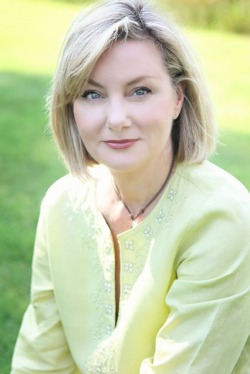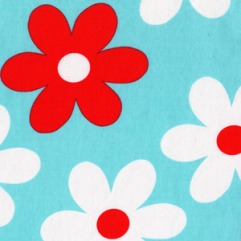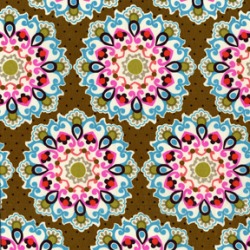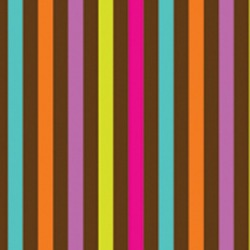Now for the juicy giveaway details: I’m giving away a signed copy of Sew Retro, along with some fabulous Michael Miller fabric, generously donated by the great folks at Michael Miller. This is no ordinary giveaway though! The lucky winner will get to pick which Michael Miller fabric they want! That’s right: you pick it--up to FIVE yards! You can pick five one-yard cuts, or a combination of one-, two-, or three-yard cuts. For a sampling of the fabric available, go to the Michael Miller Fabrics web site and click on New Product, or just follow this link. As giveaways go, this is a pretty darn cool one (I’m jealous that I can’t enter!).
A few thumbnails just to tease you . . .
And now, I bring you a Q&A with Kathy Miller!

Miller: I grew up surrounded by fabric, sewing, tons of creativity, and a “if you want it, make it happen” mentality. My mom was a home economics teacher specializing in design and tailoring. I started sewing at an early age, first making doll clothes, and then trying the same technique on my younger sister (I was ten and she was four). She was a willing model: I’d lay the fabric on the floor, and then she’d lay on top of it and I’d cut around her, hand-stitching my creation on her. Raw edges, big stitches—you get the picture! I can still remember the day our parents sat us down and said that as much as they admired my work, they didn’t think it was a good idea for her to be running around the neighborhood in these creations!
We were an Air Force family and moved to Guam when I was in high school in the late 1960s, early 1970s. It was a great time for wild prints—especially tropical prints. I loved to fabric shop, and then run home and make an outfit and wear it right away—luckily my sewing skills had improved by then!
Q: What made you want to design your own line of fabric, and how did the partnership with Michael Steiner come about?
Miller: I’m a late bloomer. I didn’t start Michael Miller until I was forty-five. I had majored in Textile Design at the Fashion Institute of Technology in New York City in 1976. After school, I worked as an artist, then assistant stylist, and finally as a stylist at many fabric companies. By then I could see the writing on the wall: different company, but more of the same thing. The money was good, but there was no real job security and I was bored. I truly loved what I did, and figured by then I knew as much as anybody else starting a fabric company. I also figured it was “now or never” since my oldest daughter was three years from starting college (her brother was right behind her). I had three years to get the business off the ground and be able to pay for college (Did I mention I work better with a deadline?).
Michael Steiner and I had worked together for seven years: he in sales, me in design. We knew we made a good team (and we still do). In the beginning, we worked out of his New York City apartment. Luckily his girlfriend (now wife), Camila, and roommate were okay with the kitchen doubling as my studio. I had a designated large drawer that I’d sweep all my supplies into every night. We moved to a real office before I took over the oven for storage! When I had a work table made for the new office, I based it on the kitchen island.
Q: Your fabrics are really eclectic, but most seem to have a retro vibe. Why are you drawn to these kinds of bold, playful prints?
Miller: I’ve always personally enjoyed retro prints. I collect a lot of vintage books and ephemera (all periods). But you’re right, the line is very eclectic. I compare being a fabric designer/stylist to being an actor: as an actor you don’t want to be type-cast. The same can be said for a designer or fabric company. Being known for one “look” or “style” can be very limiting. The joy in having your own company is being able to connect with other fabric lovers in a variety of niches (thus, a healthy business!).
Through years of styling prints for the women’s wear apparel market I learned that “color sells.” When you’re shopping for a blouse on a rack, the only thing you see is the sleeve. The print (and more importantly the color) is what draws you to pull it out from amongst the rest. That was also where I learned that vibrant, strong colors sell. They can survive terrible florescent store lighting.
Q: What is the inspiration for your retro-inspired prints? Where do you get your ideas, and how do you go about bringing them to life?
Miller: As for ideas: At this point I’m hardwired for observing everything in relation to trends, color, and design. It’s second nature to me. I’m always on the prowl for good references, and I prefer books, paper, and original vintage artwork. The dealers that know me know that I’m a sucker for the quirky and the beautiful. If it’s well done, I’ll find a place for it. I think over time most designers and stylists develop what I call a “jaded eye,” and after awhile it takes something really different, beautiful, or just plain strange to get you excited.
As for the process of bringing the design to life: When I look at a piece of reference or artwork that I like, my first question is what draws me to it? It could be just one element of it. The design will evolve from there. The color and contrast is a whole other process. The coloration that is sent to the mill for engraving and strike-off (first small swatch to check for engraving and color matching) is really just a rough outline, in my experience. When I receive that strike-off is when I really know what I’m dealing with and where the process of bringing the design to life begins! It’s all in the tweaking and is very much a mental visualizing process (and don’t get me started on why it can’t be done on the computer!).
Q: Since you started Michael Miller ten years ago, sewing among young women has boomed! Has this changed how and what you design, and who you design for?
Miller: I’m ecstatic about it! Since the beginning, our main customers have been fabric-aholics. I realized this at my first quilt market. We always figured that good design will find a home, whether it’s for quilting, clothing, or home dec. That’s the fun part about being a fabric company: we create it, put it out there, and then someone else creates something new with it.
We separated our customer service area a few years ago to cater to the new group of entrepreneurial sewers and crafters (I call them “mommy-preneurs”). It started on eBay and then moved to Etsy. It’s a predictable next step for new moms first sewing for their own families, and then as an income source that enables them to stay home with the kids.
Q: Do you still have time to sew? If so, what kinds of things do you like to make?
Miller: Sadly I don’t have much time to sew anymore. It hasn’t stopped me from buying fabric though! Most of my sewing now is for quilt markets. We have a big booth and I usually make all the customized lampshades, along with some of the display stuff.








 RSS Feed
RSS Feed